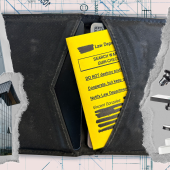Banner and intermittent artwork by autsawin uttisin, Hitdelight, BERK OZDEMIR, Chuchawan, and New Africa / Shutterstock.com
In this three-part series, you will learn how to best prepare your organization to respond promptly and lawfully to a search warrant. Part one covers readiness, preparation, and the kick-off of the search warrant response. Part two dives deeper into developing a search warrant response plan. And part three explores training via a simulated role-playing exercise.
Cheat Sheet
- Review the warrant. Check key elements of the search warrant, including the name of the court issuing the warrant, the name of the company, and the address to be searched. Inaccurate or incomplete information may leave the warrant without force.
- Teamwork. Each company facility should have its own search warrant response team, with a team leader who has the authority and expertise to escort the law enforcement officers.
- Interviewing guidelines. If an employee agrees to be interviewed, they must answer questions honestly, providing only facts and information of which that employee has actual knowledge.
- Concluding the search. Once the officers have departed, the response team should debrief — along with the company attorney to render legal advice given what just transpired.
It is important for employees to be prepared to handle a search warrant on their own, since law enforcement officers will not wait for the company’s attorneys. Therefore, you need to prepare a search warrant response plan that includes the following elements.
How to review a search warrant
Check the name of the court issuing the search warrant. This will give you a clue whether it is a federal or state law or regulation being enforced.

Check the name and matter number on the warrant. This will indicate if the case is against the company or against a related or unrelated third party.
Check the name of the company and the address of the place to be searched. This is important, because if either the name of the company or the address of the place to be searched are incorrect, then this supports the claim that the search warrant should be invalidated — though recall, from part one, that technical deficiencies alone may not be enough to invalidate the warrant.
Confirm that the search warrant is signed by the judge and is dated. An unsigned search warrant may be without force, though the validity of an unsigned search warrant is an open question in some circuits. And if the search warrant is being executed more than 14 calendar days after it was signed — as in the case of a warrant issued by a federal district court — then that may also be without force.
How to receive law enforcement officers executing a search warrant
Once the facility’s guard or receptionist ascertains that there are law enforcement officers arriving at the facility, immediately contact the team leader of the facility’s search warrant response team, as well as the company’s attorneys.
Identify who the officer in charge is and then inform them that the facility’s team leader is on site and has been summoned.
While waiting for the team leader, the guard or receptionist should confirm the identities of each of the officers and other individuals executing the warrant by asking to see their agency photo identification cards or business cards and taking photos of these documents with their mobile phone. Each of the officers should also be asked to sign in if that is the normal company procedure for visitors to the facility.
Make sure to obtain a copy of the search warrant from the officer in charge and to take a photo of each page of the search warrant, including the scope of search which is the list of items and materials for which the officers are searching.
Once the facility’s team leader arrives, he or she should carefully review the search warrant, particularly the scope of search to determine exactly what areas are to be searched and which items are to be seized. If the scope of search includes obtaining air, water, or soil samples, the team leader must ensure the escorts have the necessary tools to take split samples. In the meantime, the guard or receptionist is contacting the rest of the facility’s search warrant response team, making sure to bring in as many employee escorts as there are officers.
One key question for the team leader to address is whether, given the areas to be searched, the officers conducting the search will need to attend a safety briefing – at the very least the officers will need to know where to evacuate to in the event of an emergency. The team leader will have to reassure the officer in charge that there is no subterfuge at play, nor any intent to delay the search. They will also have to discuss, if applicable, the need for the officers to use personal protective equipment (PPE) such as hardhats, safety glasses, ear protection, and safety vests among other things. Certain kinds of PPE such as scuba gear, for example, must be individually fitted, so the facility cannot be expected to supply such PPE to the officers.
Make sure to obtain a copy of the search warrant from the officer in charge and to take a photo of each page of the search warrant.
How to organize a search warrant response team
It is critical that each company facility have its own search warrant response team. To begin with, a given facility’s employees know their own place of work better than employees from other facilities. Second, the facility’s employees would already be on-site when the officers executing the warrant arrive. And third, these employees would already have ready-to-hand the tools and materials they need for escorting the officers around the facility.

It is also critical that the facility’s response team is led by someone with real authority, such as the facility manager or director. In addition to knowledge of the facility and its operations, the team leader should also be acquainted and work well with each of the employees who comprise the response team. The team leader will need to match each escort’s expertise with the specific area or location to be searched, while ensuring a one-to-one escort-officer ratio. Finally, the team leader will need to maintain face-to-face contact with the officer-in-charge so that issues can be addressed in real time.
Ideally, the team leader should have an assistant shadowing him or her, who takes down notes and keeps a written record of decisions as well as key statements made during the entire period. This assistant will also act as the archivist responsible for keeping the officers’ business cards, hard copies of documents such as the search warrant itself, the sign-in sheet, the inventory and receipt of items seized.
The team should also include alternates or backup members, in case one or two regular team members are out on PTO or otherwise unavailable. This would include having one or two deputy team leaders in case the team leader is out on PTO or otherwise unavailable.
The facility guard or receptionist should have each team member’s mobile phone on speed dial or a global text distribution list.
How escorts should interact with officers during a search
Employee escorts play a critical role in the successful resolution of a search warrant event. To begin with, by cooperating with the officers, the escorts can ensure that the search proceeds faster and is less disruptive, while demonstrating that the company has nothing to hide of a criminal nature. But the escorts also have control, ensuring that the officers do not expand the scope of the search. For example, if an officer asks permission to enter an area or obtain a document that is clearly not within the scope of search — a signal that the officer is seeking consent to expand the search — the escort can politely yet firmly decline. If the officer persists, then the escort can respond by indicating that if the officer proceeds as requested, it will be without the company’s permission or consent. Finally, while being cooperative is important, it does not mean that the escort may provide speculative answers or volunteer information that has not been asked for.
By cooperating with the officers, the escorts can ensure that the search proceeds faster and is less disruptive, while demonstrating that the company has nothing to hide.
Interview guidelines for employees
Among the challenges that the search warrant response team will face are attempts by the officers to interview random employees who happen to be present at the facility but are not members of the response team. The team leader should consider the option of dismissing these employees and giving them the day off. This removes the risk of such interviews.
The company should develop interview guidelines for employees that emphasize two points:
(1) the employee has the absolute right to decide to be interviewed or not, and
(2) the employee must be truthful if the employee decides to be interviewed.
Making the decision whether to be interviewed or not is a sensitive issue for an employee and, therefore, the company should make it clear that it will not retaliate or take any negative action against the employee if he or she decides to be interviewed. In addition to underscoring that the decision to be interviewed always belongs to the employee, the company should also indicate that the employee is also free to refer the interviewing officer to a company spokesperson or the team leader. The employee should also know they have a right to have counsel present during the interview. The company, therefore, needs to decide if it will have a policy of covering the cost of that employee’s attorney during the interview.
If the employee agrees to be interviewed, then the company must emphasize the importance of truthfulness to that employee. This means that the employee must answer questions honestly, providing facts and information of which that employee has actual knowledge. In other words, the employee should avoid speculative answers or personal opinions, answer only the questions asked and should not volunteer information that was not asked for. Finally, the employee has the right to stop the interview at any time, particularly if the employee feels uncomfortable with the officers’ line of questioning.
How to handle certain items being seized
Some documents or materials seized by the officers pursuant to the warrant may include documents or materials marked as CONFIDENTIAL, either under the Attorney-Client Communication Privilege or the Attorney Work Product Doctrine. Other documents could also be marked as either containing confidential business information, such as customers’ private information, or company trade secrets.

The team leader or attorney should immediately object to the seizure of these documents. If the objection is unsuccessful, then the team leader or attorney should segregate these documents from the other materials or documents being seized, by placing the confidential documents in an envelope that has been conspicuously marked as containing CONFIDENTIAL DOCUMENTS and sealing the envelope.
If computers, databases, hard drives, servers, or other electronic data storage devices are seized by the officers pursuant to the warrant, the team leader should double-check to ensure that the facility has a backup of or has retained electronic copies of whatever data or information are contained in such devices. If a review of these electronic data or files indicates that some materials are CONFIDENTIAL because of the reasons above, then the company should protest the seizure of these materials. If the objection is unsuccessful, then the team leader or attorney should have the confidential materials marked as such electronically and placed in a separate electronic folder marked as CONFIDENTIAL.
If the scope of search includes obtaining air, water, soil, or other environmental media samples for analysis, then there should be a group of employee escorts who have been trained on how to take split samples and are equipped with sampling tools and devices, as well as sample bags and containers. For example, if an officer uses a Tedlar® bag to obtain a sample of emissions from a valve or an exhaust vent, then the escort should do the same with the same kind of Tedlar® bag taking a sample from the same valve or vent. Or if an officer is on the ground and takes a photo of an exhaust stack 30 feet away, then the escort should take the same photo from the same vantage point and from the same distance. It is critical for the escort to carefully observe how the officer takes these samples, in case the officer either contaminates a sample or forgets to calibrate an instrument.
Finally, the team leader must carefully observe how the officer in charge writes up the inventory of items seized, specifically regarding the electronic databases and storage devices, confidential documents, and environmental samples. The team leader or attorney should not hesitate to object if these materials are described inaccurately in the inventory.
How to conclude the search
The items seized that are listed in the inventory created during the search and the receipt given to the person from whom they were seized are the items to which the company is legally entitled once the search and any enforcement actions taken as a result have been concluded, as shown in United States v. Stallworth and DeBellis v. New York City Property Clerk.
The team leader and attorney should review the receipt to ensure its completeness and accuracy. If five air samples were taken, for example, the receipt should indicate that five air samples were taken. If certain items had earlier been objected to, such as confidential documents, then ask that these objections be reflected on the receipt for these specific items.
After the officers have departed, it is critical for the entire search warrant response team to meet immediately for a debriefing session where everyone can exchange notes and observations about what transpired during the search. It is recommended that the team leader request the company attorney to be present at this debriefing to render legal advice given what just transpired, and so that the discussion can be kept confidential under the protection of the attorney-client communication privilege. However, unless the attorney is asked to render legal advice, their attendance alone probably will not be enough to trigger application of the privilege.
- What exactly were the officers looking for? The team members should be candid and forthcoming as they each relay observations and impressions.
- Were there items seized because they were “in plain view?” The team leader (facility manager) should note this for further employee training on “good housekeeping” practices.
- Did officers search areas or seize items that did not fall within the scope of search? Company counsel should carefully note how such occurrences transpired and may want to further document this with affidavits or declarations from the employee-escorts who were involved.
- Did the escorts observe officers “interviewing” employees? If so, who were these employees? Company counsel may want to interview these employees to determine what the officers were asking about and how the employees responded.
- Did the officers observe actual non-compliant events, such as a leaking valve? If so, then the company should anticipate the issuance of a notice of violation and should confirm that the leaking valve has been fixed. The team leader (facility manager) may recommend more training and increased compliance efforts.
Practice makes perfect
While a search warrant response plan is important, proper training is crucial if members of the team are going to be prepared to respond lawfully. Learn how to conduct a search warrant training exercise in part three, Under the Microscope: Training for Proper Search Warrant Response.
Disclaimer: The information in any resource in this website should not be construed as legal advice or as a legal opinion on specific facts, and should not be considered representing the views of its authors, its sponsors, and/or ACC. These resources are not intended as a definitive statement on the subject addressed. Rather, they are intended to serve as a tool providing practical guidance and references for the busy in-house practitioner and other readers.






